PORTUGAL 2025
After re-visiting the Church of São Lourenço, we headed west towards the Spain border, and when our CarPlay GPS decided to bail right before the turnoff, we almost went to Spain.
Tavira
When it rains in Portugal, it’s a good time to go and see Cathedrals, so many cathedrals. The first one being Igreja de Santa Maria do Castelo in Tavira, also home to numerous storks.
Igreja de Santa Maria do Castelo was built in the 13th century to replace the Arab mosque that existed there, when the city of Tavira was conquered from the Moors. Originally a Gothic church , it was damaged by the 1755 earthquake, and ordered to be rebuilt by the Bishop of the Algarve at the end of the 18th century.

















The Castelo de Tavira (Castle of Tavira) is a medieval castle located in a dominant position over the mouth of the river Gilão, the settlement has developed as an important sea port since antiquity, with its predecessors dating back to the 8th century BC, passing through the hands of Phoenicians, Greeks, Celts, Carthaginians, Romans, Moors and the Portuguese crown.











The 100m high Torre da Tavira was formerly the town’s water tower and now houses a camera obscura at the top. A simple but ingenious object, the camera obscura projects a 360-degree panoramic live view of Tavira, its monuments and local events, all while you stand still... it is closed.



Igreja da Misericórdia was built between 1541 and 1551 and is considered the finest Renaissance work in the Algarve , with a special mention for its portal, which is carved with an image of Our Lady of Mercy between Saint Peter and Saint Paul. The interior is supported by columns with Renaissance capitals, but the decoration is mainly Baroque, from the 18th century.







The detail in the tile work is stunning.




So many narrow stairs that we climbed today.




The Ponte antiga de Tavira (Old Bridge of Tavira) origin dates back to Roman times when it served as part of a significant Roman road that connected Castro Marim to Faro. Though there are speculations about its exact construction date, historians generally agree that some parts may have been built during the Moorish occupation between 8th and 13th century.







We went to a little local hole in the wall Restaurante Tempero Caseiro for lunch, large portions, small prices.


Mertola
The next town we stopped in was Mertola, famous for its castle.




Once again, it's take the parking you find, and walk up the steep roads to the castle.

Along the way up the hill is Igreja Matriz de Nossa Senhora da Anunciação.
Igreja Matriz de Nossa Senhora da Anunciação is an Almoad mosque with five naves, that was erected at the end of the 12th century in this sacred place where a Roman temple was possibly established, Christianized from the 4th century,. When Mertola was integrated into the Portuguese kingdom in 1238, the moslem temple with a few alterations, was consecrated at St Mary's Church.






Mertola was conquered from the Muslims by St James of the Sword on behalf of King Sancho II in 1238. The King offered them the castle and village in recognition. The main structure was the 27 meter high keep which was completed in 1292.

















One of the rooms in the castle was dedicated to the Lynx repopulation program in Portugal. A display showing the decline of the natural Lynx population and the current project that has been rebuilding the Lynx population in specific regions of the country.

Travelling North from the Algarve, we are headed to the interior of Portugal and our next historic stop, the town of Evora.
Evora
I had some high expectation for Hotel Moov in Evora, it was created from the remains of an old bull ring. The price was cheap, and the room size reflected that. It was well located, very clean, and had a nice breakfast, but it could have been so much more. The one thing it did have was underground parking, even if you had to be a stunt driver to navigate your way in and out.




We asked the guy at the front desk for dinner recommendations, one was closed, and the
other had some pretty terrible service...
the food at Café Alentejo was ok, but the prices weren't.


A little nightime stroll through the town square and it was back to the bullring room.




March 6
Unlike the day before, it was a very nice day in Évora, it allowed us to travel through time visiting the old town chapels, palaces, and Roman ruins/monuments.


Santo Antão Church replaced an old chapel dedicated to St. Anthony the Great in 1557. Flanked by two bell towers, it served as a model for other churches in the Alentejo region at the time.














The Cathedral of Evora, built between 1186 and 1250, is a fascinating and impressive monument. Completely made of granite, its style is determined by the transition from the Romantic to the Gothic. This largest medieval church in the country was improved during the 15th and 16th centuries.
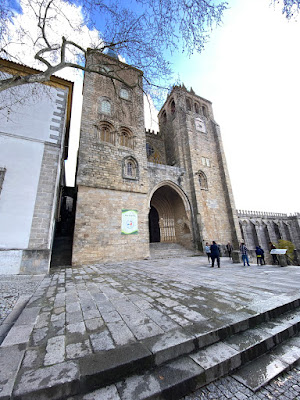




The roof is accessed through a narrow spiral staircase of 135 steps in a bell tower, but it is worth it. They take you to the upper part of the Cathedral, where you can see more of the roof structure, and gives great views over the city.





Surprisingly the sundial actually showed the right time.



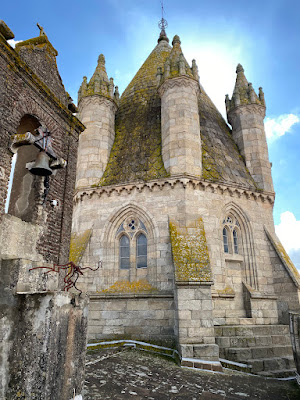

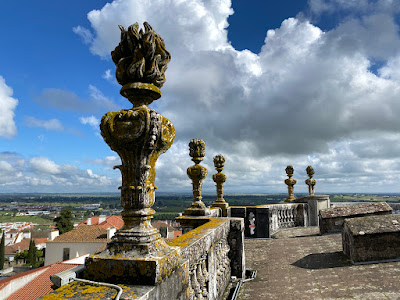

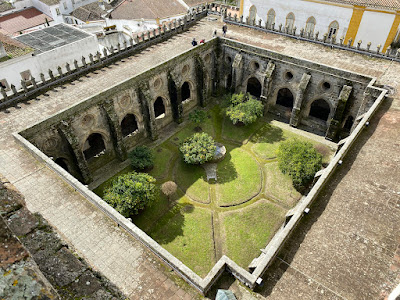
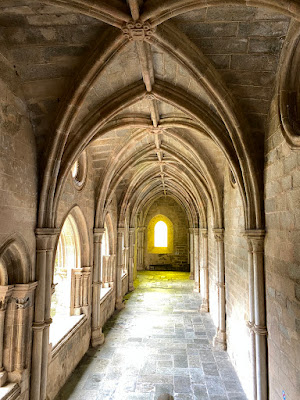














Not far from the Cathedral is Templo Romano.
The Templo Romano (Roman Temple) in Évora was built in the first century, during the time of Caesar Augustus. It has a long history, serving as testimony to many transformations and different uses over the centuries. It was practically destroyed when the Barbarians occupied the Iberian peninsular in the fifth century, and served as a bank vault and butcher’s to Evora castle in the 14th century.





The Igreja de São João Evangelista was built as the temple that would be the resting place of a count and his family in 1485, this is one of Portugal’s most beautiful churches. It was part of a convent that’s been turned into a hotel, and is now privately owned.








Apparently bones in churches are a regular thing.



It’s connected to the 14th-century Cadaval Palace, which is still an aristocratic residence but that opens part of its interior for temporary exhibitions. Those range from sacred to contemporary art, we checked it out, and it wasn't even worth taking a picture.









Porta Nova appears to be the remains of a 16th century aqueduct, erected between 1532 and 1537, but the carved stones date back to 1040.











As we wander through the old town, there is narrow alleyways and arches everywhere.






We spotted a very unique building, and went to go see it, but were stopped by a military guard.
The Igreja da Graça is an old church and convent that is used by the Portuguese Armed Forces and is now called Messe Militar de Evora. Its construction was concluded in 1511 and it is now classified as a National Monument.


Since we hadn't seen enough churches for the day, our next stop was a couple of adjoining buildings; The Igreja de Mosteiro de São Francisco and Capela dos Ossos.
The Igreja de Mosteiro de São Francisco was built in the Gothic style between 1475 and the 1550s to the design of Martim Lourenço, replacing an earlier Romanesque church of 1226.



















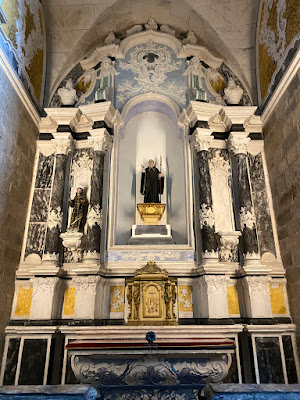


Hidden behind a non descript door next to St. Francis is the other chapel of bones...
The Capela dos Ossos (Chapel of Bones) was completed by Franciscan friars in 1816. An estimated 5,000 corpses of ordinary people buried in Évora were exhumed to decorate the walls of the chapel.






Having seen enough churches for the day, we decided to get out of the city to see standing stones dating from 3000 BC


Almendres Cromlech, Huge oval boulders, looking like gigantic stone eggs (some 3 meters/10 feet tall), stand on the ground, forming a mysterious circle. It's one of Europe's largest prehistoric monuments and said to be one of the continent’s (and humankind’s) oldest, formed about 7,000 years ago with close to 100 stones. Often called the "Portuguese Stonehenge," it’s actually 2000 years older than the famous monument in England. Geometrically aligned in relation to the equinox, it’s believed to have been associated with astronomical observation and sacred rituals, especially during the sunrise on the summer solstice. About a dozen monoliths still show carved drawings (snake-like shapes and circles), which have miraculously survived to this day and remain a mystery.













There is a small rope fence surrounding the stones, and informational signs asking people to keep their distance and help preserve the stones. But as we are leaving, two ladies from New York step over the rope to get those Instagram photos recreating their Outlander moment.
The Almendres Menhir (Menir dos Almendres) is located in the middle of a slope down a narrow path through farmlands, about 1.3km northeast of the Almendres cromlech. This monolithic monument was carved in granite, presenting an elongated ovoid shape, about 4 meters tall, and is chronologically dated between 5500 - 2000 BC. The menir and cromlech appear to be aligned during the summer solstice.





We stopped at the Tourist Information center which is made of cork, and learned a lot about the cork industry.

The entire area of these stones are surrounded by trees with their bark removed and painted numbers on them. This is the Portuguese Cork Tree industry. Cork is actually the bark from a Portuguese Oak tree. The bark is stripped from the tree in a precisely measured width based on the thickness of the tree. Once it is stripped a number is painted on the tree that is the last number of the year. After 9 years the tree bark can be stripped again. This completely blew my mind as I assumed there was a Cork Tree that was chopped down to make cork, not a renewable process repeated every 9 years.




Our final prehistoric stop was the Great Dolmen of Zambujeiro, you park in an open area of a farm beside a doggie hotel and walk across pastures with wandering cows, opening and closing gates as you go.




The Anta Grande do Zambujeiro Dolmen is one of the largest in the world. Consisting of a burial chamber and elongated corridor, which is oriented toward the east. This complex was built about 5500 years ago, about the same time as the pyramids.
Once we reach the monument we notice it is covered by a tin roof to help protect the structure from the elements and further decay. You cannot enter as the entrance is boarded up with bracing to support the upper stones. The entryway to the chamber is lined with upright stones about ½ the size of the cathedral stones. You can view inside the chamber from behind and above, and older large stone pieces of the structure are scattered in the area surrounding it. We were at this site for about 20 minutes and were the only ones there.









As we are heading back we pass remains of the 18 mile long aqueduct that was built in 1532 to provide a water source to Evora.


Once we were back in Evora, we parked the car and wandered over to the Royal Palace of Evora.
The Royal Palace of Evora has its origins in a convent built in the 13th century. During the 14th century, the convent came under royal use when the royal family was in the Alentejo, but only became a proper palace under the reign of King John I, who used it as a personal retreat from the court. It became a royal palace during King Afonso V's reign, though it was the successive reigns of King John II and Manuel I that turned the originally ordinary palace into a grandiose renaissance palace, truly fit for a king. Over the centuries, the palace fell prey to war, decay, and urban redevelopment, which destroyed nearly all of the palace, with only a few segments of the palace still existing.














Monumento aos Mortos da Grande Guerra, a monument to the Great War built in 1920.


The Chapel of Saint Blaise, located outside the city walls, is an extraordinary building that looks like a medieval castle but is a sanctuary dedicated to St. Blaise, completed in 1485 in thanksgiving for the end of the plague epidemic. It was closed.




Tonight we had dinner at the recommended place called Medieval, the food was quite good and so was the service. Norine ordered what she thought was a glass of Rose, and got the whole bottle.


We would pack up tonight and make our way to the historic walled city of Obidos in the morning.


